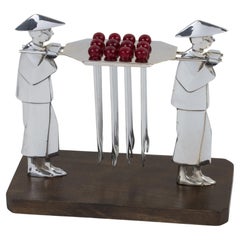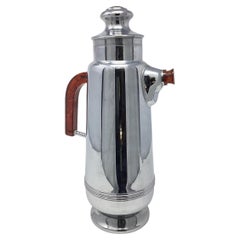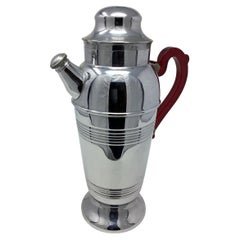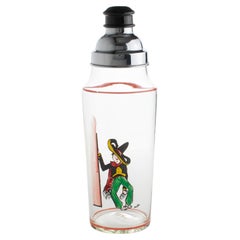Studio Art Deco-Lavina Barware
to
1
1
1
1
1
1
1
1
1
1
1
1
1
1
1
19
245
129
95
94
Creator: Studio Art Deco-Lavina
Art Deco Bakelite and Chrome Barware Cocktail Picks Server, circa 1930
By Studio Art Deco
Located in Atlanta, GA
This exquisite barware cocktail pick features two carved chromed metal carriers with a central holder. The rare piece was crafted in France circa 1930. Twelve metal cocktail forks wi...
Category
1930s French Art Deco Vintage Studio Art Deco-Lavina Barware
Materials
Metal
Related Items
Art Deco Chrome Cocktail Shaker with Brown Bakelite Handle
Located in Chapel Hill, NC
Art Deco Chrome Cocktail Shaker with Brown Bakelite Handle and Spout Cover.
Category
1930s American Art Deco Vintage Studio Art Deco-Lavina Barware
Materials
Chrome
Art Deco Chrome Cocktail Shaker with Red Bakelite Handle
Located in Chapel Hill, NC
Art Deco Chrome Cocktail Shaker with Red Bakelite Handle
Category
1930s American Art Deco Vintage Studio Art Deco-Lavina Barware
Materials
Chrome
1930s Art Deco Style Chrome and Ruby Red Bakelite Cocktail Shaker
Located in Philadelphia, PA
An Art Deco style chrome plated Mid-Century Modern Era cocktail shaker, circa 1930s–1940s.
This cocktail shaker and server is perfect for your ‘Retro Mad Man's' bar. The three piece server is complete with a Ruby Red translucent Bakelite wing-shaped handle, a fitted lid, and a screw on pour spout cap. The spout has a built-in strainer, the smooth body sits on a pedestal base.
The handle tests for bakelite and is attached to the chrome shaker...
Category
1930s American Art Deco Vintage Studio Art Deco-Lavina Barware
Materials
Chrome
Art Deco Ashtray Stand, Chrome and Bakelite by Demeyere, Belgium, 1930s
By Demeyere
Located in Verviers, BE
Art Deco Ashtray Stand, Chrome and Bakelite by Demeyere, Belgium, 1930s
This beautiful and rare Art Deco Ashtray Stand from the 30s is in the streamline modern Art Deco style.
The ...
Category
1930s Belgian Art Deco Vintage Studio Art Deco-Lavina Barware
Materials
Chrome
$946
H 28.35 in W 18.12 in D 9.45 in
Manning Bowman Art Deco Bakelite and Chrome Cocktail Shaker and Serving Tray
By Manning Bowman
Located in Chapel Hill, NC
Manning Bowman Art Deco Bakelite and Chrome Cocktail Shaker and Serving Tray. A nice sized chrome plated cocktail shaker with a mustard colored top cap. Manufactured by the Manning B...
Category
1930s American Art Deco Vintage Studio Art Deco-Lavina Barware
Materials
Chrome
$695 / set
H 12 in Dm 4 in
Art Deco Chrome & Wood Cocktail Pick Set w/Bird Landing in Tree to Pick Berries
Located in Nantucket, MA
Art Deco cocktail pick set with a chrome figure of a bird landing on a tree standing on an octagonal wood base next to a chrome cylinder holding six forked cocktail picks, each toppe...
Category
Early 20th Century French Art Deco Studio Art Deco-Lavina Barware
Materials
Chrome
$350
H 3.75 in W 3.38 in D 3.38 in
French Art Deco Bakelite Cocktail Picks - Rabbit with Toadstool
Located in Nantucket, MA
Art Deco Bakelite cocktail pick set - a rabbit standing next to a toadstool by a Bakelite cylinder holding 9 cocktail picks topped with diagona...
Category
Early 20th Century French Art Deco Studio Art Deco-Lavina Barware
Materials
Metal
Set of 12 Art Deco Red Ball Top Cocktail Picks in a Chrome and Gold-Tone Holder
Located in Chapel Hill, NC
Set of 12 cocktail picks with red Bakelite ball tops and forked picks resting on a gold-tone pallet carried by poles on the shoulders of two chrome finished men standing on a wood base.
Category
Early 20th Century French Art Deco Studio Art Deco-Lavina Barware
Materials
Chrome
$895
H 5.25 in W 5.88 in D 2.5 in
Art Deco 1930's Serving Barware Drinks Tray
Located in Devon, England
A cute size and original 1930's German Art Deco tray featuring a lovely reverse painted design on glass. Condition is very good, no damage, minor signs of age. Very distinctive Deco ...
Category
Mid-20th Century German Art Deco Studio Art Deco-Lavina Barware
Materials
Glass, Softwood, Paint
1930's-1950's Art Deco Cocktail Shaker with Bakelite Handle
By Farber Bros.
Located in Louisville, KY
Let's assume you have a bar in your home. You love the lines of the Art Deco period. You pride yourself in seeking out the unique for the spaces in your life. You love the notion of ...
Category
Early 20th Century American Art Deco Studio Art Deco-Lavina Barware
Materials
Chrome
Art Deco Cocktail Pick Set, 2 Each of 6 Colors, Bakelite and Chrome Apple Stand
Located in Nantucket, MA
Set of 12 French, Art Deco cocktail picks (2 each of 6 colors), together with a stand having a red Bakelite and chrome apple on a wood base in front of a perforated metal arch which ...
Category
Early 20th Century French Art Deco Studio Art Deco-Lavina Barware
Materials
Chrome
$395
H 3.5 in W 6.75 in D 2.25 in
Art Deco Chrome and Black Bakelite Ball-Top Cocktail Picks and Snail-Form Stand
Located in Nantucket, MA
Art Deco cocktail picks with black Bakelite ball tops in a snail-form chrome stand with carved black Bakelite shell.
Category
Early 20th Century French Art Deco Studio Art Deco-Lavina Barware
Materials
Chrome
$395
H 5 in W 5 in D 2.88 in
Previously Available Items
Art Deco Barware Tall Glass Martini Cocktail Shaker with Cartoonist Decor
By Studio Art Deco
Located in Atlanta, GA
This gorgeous Art Deco Martini or cocktail shaker was crafted in The United States circa 1930. This three-cylindrical sectioned form has a removable cap and filter strainer. The shak...
Category
1930s American Art Deco Vintage Studio Art Deco-Lavina Barware
Materials
Metal, Aluminum, Enamel
Studio Art Deco-lavina barware for sale on 1stDibs.
Studio Art Deco-Lavina barware are available for sale on 1stDibs.
Creators Similar to Studio Art Deco-Lavina
Questions About Studio Art Deco-Lavina Barware
- What was the Art Deco movement?1 Answer1stDibs ExpertMay 30, 2024The Art Deco movement was a decorative style popular during the 1920s and ’30s. Few design styles are as universally recognized and appreciated as Art Deco. The term alone conjures visions of the Roaring Twenties, Machine Age metropolises, vast ocean liners, sleek typography and Prohibition-era hedonism. The iconic movement made an indelible mark on all fields of design, celebrating society's growing industrialization with refined elegance and stunning craftsmanship. Widely known designers associated with the Art Deco style include Émile-Jacques Ruhlmann, Eileen Gray, Maurice Dufrêne, Paul Follot and Jules Leleu. The term Art Deco derives from the name of a large decorative arts exhibition held in Paris in 1925. On 1stDibs, shop a wide range of Art Deco furniture and decorative objects.
- What is an art deco watch?1 Answer1stDibs ExpertApril 5, 2022An art deco watch is defined by its geometric case, which is either circular or rectangular. The watch style was highly popular between 1920 and 1950, and is still sought after today. You’ll find a collection of art deco watches from some of the world’s top sellers on 1stDibs
- What is art deco jewelry?1 Answer1stDibs ExpertFebruary 22, 2021Art Deco jewelry was popular during the design movement of the 1920s and 30s. Art Deco jewelry is typically characterized by geometric patterns and gemstones of contrasting colors.
- What is the history of Art Deco?1 Answer1stDibs ExpertMarch 25, 2024The history of Art Deco begins in the early 20th century.
Art Deco emerged as a global design style around the start of World War I, during the last years of Art Nouveau's popularity. The style conjures visions of the Roaring Twenties, Machine Age metropolises, vast ocean liners, sleek typography and Prohibition-era hedonism. Its hallmarks include the use of geometric designs influenced by Cubism. Major discoveries of Egyptian tombs during the era also influenced the movement.
The term Art Deco derives from the name of a large decorative arts exhibition, the Exposition Internationale des Arts Décoratifs et Industriels Modernes, held in Paris in 1925. After World War II, tastes shifted toward more functional, less ornate modernism, but today, the Art Deco style is still favored for its luxurious sophistication. On 1stDibs, shop a large selection of vintage Art Deco furniture. - What defines Art Deco?1 Answer1stDibs ExpertApril 5, 2024A few things define Art Deco. Date is one factor, as the style emerged in the 1920s and remained popular during the 1930s. Art Deco design usually includes bold geometric lines and forms or intricate repeating floral motifs. Designers working in this style tended to use expensive materials, such as shagreen or marble, as well as exotic woods like mahogany, ebony and zebra wood. Furniture often featured metal accents, mirrored finishes and embellishments made from exotic animal hides and inlays of mother-of-pearl or ivory. Shop a wide range of Art Deco furniture on 1stDibs.
- What is an Art Deco lamp?1 Answer1stDibs ExpertApril 5, 2022An Art Deco lamp is any lamp that’s made in the styles of the Art Deco movement, which was dominant in the 1920s and 1930s. On 1stDibs, you’ll find a collection of Art Deco lamps from some of the world’s top sellers.
- What is art deco ring?1 Answer1stDibs ExpertAugust 17, 2021Art Deco rings were made during the early 20th century. Named for a design movement that originated at a large decorative arts exhibition held in Paris in 1925, Art Deco rings are generally quite geometric, symmetrical and incorporate a variety of gemstones — especially sapphires and emeralds. Find a wide variety of Art Deco rings for sale on 1stDibs.
- When did Art Deco originate?1 Answer1stDibs ExpertFebruary 1, 2024The Art Deco period originated in France. Its name comes from the title of a large decorative arts exhibition held in Paris in 1925, credited with introducing the style to the world. It was informed by ancient Egypt, Cubism, Futurism, Louis XVI, De Stijl, modernism and the Vienna Secession and went on to influence the Streamline Moderne and mid-century modern movements. Shop a wide range of Art Deco furniture, decorative objects and jewelry on 1stDibs.
- What was Art Deco influenced by?1 Answer1stDibs ExpertMay 3, 2024Art Deco was influenced by a number of things. The discovery of ancient tombs around the turn of the century led to a renewed interest in Egyptian furniture and architecture that inspired Art Deco designers. Art Deco was also informed by Cubism, Futurism, Louis XVI style, De Stijl, modernism and the Vienna Secession. Shop a large collection of Art Deco furniture, decorative objects and jewelry on 1stDibs.
- How do I identify Art Deco?1 Answer1stDibs ExpertApril 5, 2022To identify Art Deco, look for the characteristics of the period. Furniture produced at the time is generally lacquered metal with a mirror-like glossy finish. Wooden items should be an exotic wood. Most items feature symmetrical designs, and geometric forms were popular motifs during the period. In addition, Art Deco often shows the influence of Hellenistic, Egyptian and Asian designs. Shop a variety of Art Deco furniture and decorative objects on 1stDibs.
- 1stDibs ExpertAugust 15, 2019
The main difference between Art Nouveau and Art Deco is that the former is detailed and ornate, and the latter is sharp and geometrical. When the movement started at the end of the 19th century, Art Nouveau was heavily influenced by nature and the curved lines of flowers. Art Deco, which became popular in the beginning of the 20th century, was inspired by the geometric abstraction of cubism.
- Are Art Deco rings timeless?1 Answer1stDibs ExpertOctober 30, 2023Yes, Art Deco rings are timeless by many people's standards. Inspired by architecture, Art Deco jewelry pieces show off intricate geometric designs that have remained stylish decade after decade. Plus, the most commonly used materials during the Art Deco period, like platinum and 14-karat yellow gold, are classics. Shop a variety of Art Deco rings on 1stDibs.
- 1stDibs ExpertApril 5, 2022There are a few tell-tale signs you can look for to determine if a ring is from the Art Deco period. The first big sign is if it has a geometric element to it, as this was a big element of all Art Deco designs. Colored stones were also very popular in the period and it’s not uncommon to see sapphires or rubies taking center stage, rather than a diamond. During the Art Deco period, yellow gold was not very common, instead, jewelers crafted pieces of white gold or platinum. Shop a collection of authentic Art Deco jewelry from some of the world’s top boutiques on 1stDibs.
- 1stDibs ExpertMarch 31, 2023The simplest way to make an Art Deco bedroom is to purchase authentic furniture and decorative accents from the 1920s and ‘30s. Top designers from the period include Émile-Jacques Ruhlmann, Eileen Gray, Maurice Dufrêne and Jules Leleu. Pair authentic Art Deco pieces with a bedding set in a colorful, intricate floral print, or dress up the walls with wallpaper in a geometric motif with hints of gold. The iconic Art Deco movement made an indelible mark on all fields of design throughout the 1920s and ’30s, celebrating society’s growing industrialization with refined elegance and stunning craftsmanship. Find a selection of Art Deco furniture and decor from some of the world's top sellers on 1stDibs.
- What does Art Deco ring mean?1 Answer1stDibs ExpertFebruary 17, 2023The term Art Deco ring means a ring produced in the Art Deco style. Most Art Deco jewelry dates back to the 1920s and 30s and features defined lines and geometric motifs. While a lot of Art Deco rings were black and white — the black coming from the use of onyx or black enamel and the white from rock crystal and diamonds — there is plenty of color in jewelry of the era. A perfect accent to diamonds in platinum settings were blue sapphires, emeralds and rubies, and these stones were also used in combination with each other. On 1stDibs, find a variety of Art Deco rings.
- What era was Art Deco rings?1 Answer1stDibs ExpertJune 30, 2023Art Deco rings are from the era of the 1920s and 1930s. While Art Deco began to emerge a bit earlier than that, the style truly gained momentum after the end of World War I. Rings from the time period often feature geometric motifs, bold colors and designs that were influenced by Cubism, Futurism and other movements in visual art. Diamonds were exceptionally popular, while accent gems such as sapphires, emeralds and rubies brought vivid color to engagement rings and added sophistication and glamour. On 1stDibs, shop a variety of Art Deco rings.
- 1stDibs ExpertAugust 26, 2024The difference between Memphis and Art Deco is that the terms refer to two different design styles. Art Deco emerged in the 1920s, and its pieces often flaunt bold geometric lines and forms, floral motifs and ornamental details, such as mirrored finishes and inlays of mother-of-pearl or ivory. Named after the Memphis Group, which formed in 1980, Memphis design emphasizes freedom of expression, dizzying patterns and off-the-wall colors. Some people describe it as Art Deco meets Pop art. On 1stDibs, find a collection of Art Deco and Memphis design furniture.
- What is Art Deco’s time period?1 Answer1stDibs ExpertSeptember 25, 2019
The Art Deco era is 1925 to 1940.
- 1stDibs ExpertFebruary 27, 2024In its time, Art Deco went out of style due to shifts in trends. After World War II, designers became more interested in modernism and creating pieces with an emphasis on function and simplicity, a move away from the embellishment and adornment that characterized the Art Deco style. It's important to note that Art Deco never fully disappeared. In fact, many present-day collectors have a passion for pieces produced during the 1920s and ’30s. Shop a large selection of Art Deco furniture on 1stDibs.
- 1stDibs ExpertFebruary 1, 2024The years between 1920 and 1939 are generally considered to be the age of Art Deco. However, the name of the movement didn't arrive until 1925, when the Exposition Internationale des Arts Décoratifs et Industriels Modernes in Paris, France, introduced Art Deco design to the world. After the 1930s, Art Deco continued to have an impact, influencing the Streamline Moderne and mid-century modern styles. On 1stDibs, explore a large selection of Art Deco jewelry, furniture and decorative objects.
Recently Viewed
View AllMore Studio Art Deco-Lavina Furniture
Studio Art Deco-Lavina Centerpieces
Studio Art Deco-Lavina Decorative Objects
Studio Art Deco-Lavina Building and Garden Elements
Studio Art Deco-Lavina Tables
Studio Art Deco-Lavina Decorative Boxes
Studio Art Deco-Lavina Desk Sets
Studio Art Deco-Lavina Bookends
Studio Art Deco-Lavina Cigar Boxes and Humidors
Studio Art Deco-Lavina Candlesticks
Studio Art Deco-Lavina Wall Clocks
Studio Art Deco-Lavina Coat Racks and Stands
Studio Art Deco-Lavina Umbrella Stands



